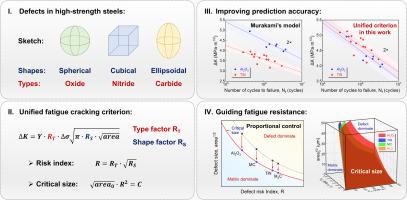Fatigue cracking criterion induced by defects in high-strength steel
IF 14.3
1区 材料科学
Q1 MATERIALS SCIENCE, MULTIDISCIPLINARY
引用次数: 0
Abstract
Defects affect fatigue performance of high-strength steels significantly, which can be quantitatively enunciated from the perspective of defect size, but not from the perspective of defect shape and type to date. In this work, fatigue crack initiation behaviors at various kinds of high-strength steels containing defects with different shapes and types are comprehensively analyzed. Based on Murakami’s model quantitatively expounding the effect of defect size on the fatigue cracking behaviors of high-strength steels, the damage factors considering defect shape and type, which reflect the intrinsic characteristics of defects, are rationally proposed and introduced. Accordingly, the effects of defect size, shape and type on the fatigue cracking mechanisms of high-strength steels are revealed quantitatively. Finally, a unified fatigue cracking criterion induced by defects in high-strength steels is established, achieving the normalized quantitative description of fatigue cracking behaviors induced by different kinds of defects. The critical size criterion for different kinds of defects inducing the fatigue crack initiation behaviors of high-strength steels is revealed, and a reasonable design strategy for enhancing the fatigue resistance of high-strength steels with multiple kinds of defects is proposed.

高强钢缺陷诱发疲劳裂纹判据
缺陷对高强钢疲劳性能的影响很大,目前还不能从缺陷尺寸的角度定量阐述缺陷对高强钢疲劳性能的影响。本文全面分析了含不同形状和类型缺陷的各种高强钢的疲劳裂纹起裂行为。在定量阐述缺陷尺寸对高强钢疲劳开裂行为影响的Murakami模型的基础上,合理提出并引入了反映缺陷内在特征的考虑缺陷形状和类型的损伤因子。从而定量地揭示了缺陷尺寸、形状和类型对高强钢疲劳开裂机理的影响。最后,建立了统一的高强钢缺陷诱发疲劳裂纹判据,实现了对不同类型缺陷诱发疲劳裂纹行为的规范化定量描述。揭示了引起高强钢疲劳裂纹萌生行为的不同类型缺陷的临界尺寸准则,提出了提高具有多种缺陷的高强钢抗疲劳性能的合理设计策略。
本文章由计算机程序翻译,如有差异,请以英文原文为准。
求助全文
约1分钟内获得全文
求助全文
来源期刊

Journal of Materials Science & Technology
工程技术-材料科学:综合
CiteScore
20.00
自引率
11.00%
发文量
995
审稿时长
13 days
期刊介绍:
Journal of Materials Science & Technology strives to promote global collaboration in the field of materials science and technology. It primarily publishes original research papers, invited review articles, letters, research notes, and summaries of scientific achievements. The journal covers a wide range of materials science and technology topics, including metallic materials, inorganic nonmetallic materials, and composite materials.
 求助内容:
求助内容: 应助结果提醒方式:
应助结果提醒方式:


